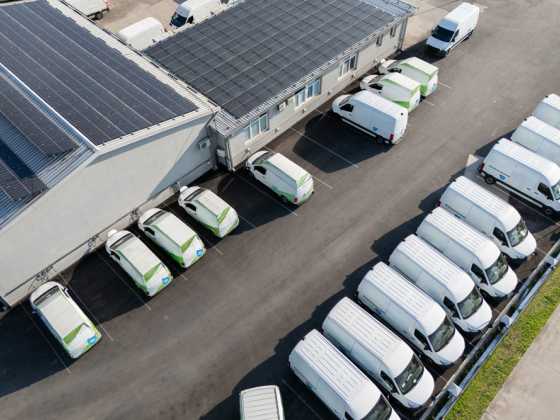Expert Panel: Moving to Electric

While the phase out for new diesel and petrol vehicles is a few years away, preparing for the switch to electric vehicles now will help future-proof fleet operations. So for those looking to adopt electric vehicles for the first time, or expand their existing EV fleet, our expert panelists answer some key questions:
The latest figures from the SMMT show that battery electric vehicles and plug-in hybrids reached 17% of the market in July. What would you say are the main reasons that the sales of EVs is picking up pace?
Gavin Franks, director business services at the AA: Put simply, drivers are realising the benefits of EVs. We know this because we’ve just launched our fifth Operational Fleet Report in partnership with Rivus Fleet Solutions, which gathered the opinions of over 500 fleet managers. The research found that 82% of fleet operators feel the quality of EVs on offer has improved since last year and 84% believe the range from manufacturers has also improved. The positivity around EVs has also extended to the long-term cost benefits, with almost two thirds (65%) believing that EVs have better whole life costs than diesel or petrol.
Looking ahead, we’ll see this pace of adoption pick up further. Our research shows that 26% of fleet operators are using EVs and 67% expect to be using them within the next five years. Fleets have been the early adopters with EV and we’re now at the point where we’re starting to see the wider consumer market realising the benefits.
Colin Ferguson, co-founder & CEO, The Algorithm People: It’s a combination of factors, with government policy driving demand and the race to net zero making a difference. Fleets are adopting decarbonisation strategies as they look to transition to electric and other low emission vehicles. The vehicles themselves and choices that are available on the market, increasing infrastructure availability and overall range, are all having a positive impact.
David Savage, associate vice president UK & Ireland, Geotab: There are a number of reasons for the growth trajectory of electric vehicles (EVs) over the past couple of years. The early adopter fleets are demonstrating the viability of EVs - not just in terms of range but also the price point for EVs in comparison to their Internal Combustion Engine counterparts (ICE). Consumers are increasingly becoming aware of the Total Cost of Ownership (TCO) benefits of owning an EV over the lifetime of a vehicle, along with the environmental benefits of ‘clean’ motoring. It is both an ethical and economic win-win situation.
The infrastructure network is also improving dramatically. There is a greater availability of charging options, particularly for those without off-street parking. Fleets are beginning to utilise more forms of charging infrastructure that are suited to their needs. Studies show that UK businesses are planning to invest more than £15bn in electrifying their fleets and a third will invest in home charging options for employees in the coming years.
On top of that are government incentives to go green. On the one hand, there are a number of initiatives to discourage the use of ICE vehicles, such as the Low Emission Zones in London and other major cities in the UK. The UK government plans to ban the sale of new ICE vehicles completely, starting in 2030. On the other are positive initiatives to go electric. Plug-in grants, tax benefits, including benefits-in-kind and the emergence of EV salary sacrifice schemes are all major incentives to make the switch to EVs.
Matthew Stokell, national sales manager, Lookers Leasing: Undoubtedly, fiscal taxation is driving the sale of EV’s predominately into corporate customers. The BIK rates of 1% for the next two years is a massive driver for the adoption of electric vehicles on fleets. The wider public sector are also being targeted by central government to operate cleaner fleets and electric vehicles is the spearhead to do this. The PICG boosted sales and contributed to an increase in BEV market share, especially before the reduction. We’re now seeing commitments from large organisations to go carbon neutral as soon as possible – this is being driven either by a their core values, an excuse for fashionable PR or cost savings; it could be a mix of
the three.
Lee Brown, head of 0Zone, The Grosvenor Group: There are so many reasons we could cite for the growth in demand for electric vehicles, such as the improved choice from manufacturers, the fact that people are driving less due to the pandemic (leading to less issues with range anxiety), the BIK benefits, the improved technology and the fact that many company car choice lists are now moving to ultra low emission and electric vehicles.
However, what we’re really witnessing is the classic product lifecycle model that we see in all aspects of life. Any new product or innovation goes through its natural stages, which are its development, introduction, growth, maturity, saturation and then finally its decline.
During the initial stages, ‘early adopters’ who are those people who are most likely to try out new technology make the first tentative purchases and get the market moving and then as the rest of us see how well it works we all begin to jump on board which moves the product into its growth stage.
With electric vehicles, anyone who was initially hesitant is now seeing these vehicles on our roads, in company car parks and in their neighbour’s driveways. Additionally, if there were any concerns that they may be constantly running out of charge or breaking down they haven’t seen any EV drivers stranded by the roadside and so they are now thinking ‘I’d like one of those’ – and that’s when we see the market accelerate in the way that it is.
The added incentive is, of course, that its now pretty expensive tax-wise to choose a traditional ICE engine car and so as company car drivers weigh up the pros and cons of their next vehicle, anything under 50g/km CO2 is looking really appealing. Also for companies choosing a Salary Sacrifice scheme, and at Grosvenor we are seeing strong demand for ours, the financial benefits are particularly attractive – and within all of this everyone who opts for an EV is feeling positive about the benefits to the environment.
Richard Parker, corporate sales manager, Webfleet Solutions: These latest figures signal the fast-paced change occurring in the industry and a turning point in terms of electric uptake. The month of July was the third time battery electric vehicles overtook sales of diesel in the past two years – and the second consecutive month – a trend we can expect to see continue. Low-carbon objectives permeate almost every aspect of our daily lives and the upcoming diesel ban looms large for all drivers, fleet and private, so it is little wonder that we are seeing the influence on the market. The sustained fall in demand for diesel and rising demand for electric cars underlines this.
We are also tentatively emerging from the pandemic and returning to ‘business as usual’. As drivers return to the road, recreationally and professionally, many businesses, and indeed families, are reviewing their transport needs. The purchase of new vehicles is set to become more of a priority, and EVs are more of a conscious social and climatic choice for drivers. Furthermore, following the crisis, businesses have their eye fixed firmly on future-proofing their operations, and this includes the procurement of a sustainable, efficient and fit-for-purpose fleet.
Lastly, confidence in EVs is growing, boosted by manufacturer commitments, technology advancements, improved range capabilities, government investment and incentives, including VAT exemptions and charging grants, and falling purchase prices as new models come to market.
From a fleet perspective, technology platforms that allow for greater access to valuable insights is helping to ease concerns and identify opportunities for effective EV adoption.
For example, telematics solutions can provide the data to inform feasibility assessments and highlight which fossil fuel vehicles could be replaced with EV alternatives, based on their daily mileages.
This makes for a more seamless and frictionless switch, which is likely to influence future EV sales rates.
The drive to a zero-carbon future is well under way, but collective efforts must continue to be made by all stakeholders to accelerate the electric transition.
Government must continue to incentivise and support the transport sector’s green ambitions, research and development of eco-tech innovations must continue apace, consumers must continue to embrace sustainable mindsets while fleets must look to adopt progressive decarbonisation strategies. Complacency is not an option.
Mark Constable, head of business development, Trojan Energy: It’s only ever been about the product: price, segment, brand, availability. Surveys can cite infrastructure worries, battery life and raw materials sourcing, but every EV available in the UK is sold (or more often leased), sometimes despite the auto industry’s best efforts. Those other factors are very real, but they don’t drive adoption (or otherwise) at this point in the market.
As more EV models come on-stream - covering more vehicle types, more brands, with higher UK allocations, shorter lead times, longer ranges and cheaper price points - then it logically follows that an ever greater proportion those who were only waiting for the right vehicle to come along are able to make the switch.
Those factors are not enough to make an entire market switch, of course, but deep and broad battrification (I don’t like electrification in auto - it’s open to too much 48V abuse) will drive a big proportion of the switchers yet to jump. The UK historically buys more convertibles than any other country in Europe - how many buyers will only switch for an electric one?
Despite the growing market share, there is still a long way to go before electric vehicles take up the majority of the market share. What do you think is putting businesses off from purchasing electric vehicles at this time?
Gavin Franks, director business services at the AA: In recent years we’ve been used to research pointing to a lack of understanding of EVs as one of the main barriers to adoption but there’s now a much greater awareness among fleets of the full range of EV benefits. Our research shows that fleets are concerned with the practical elements of how EVs will work in their daily lives, such as whether the infrastructure is available to support them. We found a concern over lack of charging points across the country and at work were the top two barriers to take-up. This is positive, as we know the charging infrastructure is improving on an almost daily basis as investment in charging points is paying off, so fleets will see a change quicker than they anticipate.
Colin Ferguson, co-founder & CEO, The Algorithm People: In the recent past, range was the word we heard the most as a blocker to decision making, along with payload and infrastructure limitations. However, the market is moving on at pace and the latest figures from the SMMT show attitudes and procurement decisions are changing. I believe we will continue to see a year on year increase in EV sales, as fleets move from the early adopters phase into the early majority.
David Savage, associate vice president UK & Ireland, Geotab: Often, a key deterrent for companies is the perceived cost of EV fleet transition. This can be accompanied by the common misconceptions surrounding range anxiety and performance of modern EVs.
It can be a challenge to overcome these due to lack of access to data that demonstrates the true benefits available by transitioning all or part of their fleet to EV. Battery technology is improving all the time and vehicle manufacturers continue to push the boundaries of what is possible with EV technology - fleet managers need the data to empower their business decisions and justify the significant up-front investment as part of their business strategy.
This is partly why we developed our Electric Vehicle Suitability Assessment Tool (EVSA), as it offers in-depth data analysis for a wide range of EV makes and models to help businesses transition fleets towards greener, electric energy, in support of the fight against climate change. The EVSA works by matching existing fleet telematics data to real-world EV performance data. By analysing a fleet’s telematics data over a period of
as little as three weeks to 12 months, it then creates an electrification recommendation based on each vehicle’s distinctive driving patterns.
The results from our latest study shows almost four-in-ten fleet vehicles in the UK could switch to electric and save money over the course of the vehicle’s life. That could happen today. Analysing data from more than 3,400 vehicles operating in the UK across all industries, the research offers valuable data for organisations seeking to determine EV suitability for their fleet.
Having access to that data is crucial in demonstrating to businesses they have a viable opportunity to switch to electric.
Lee Brown, head of 0Zone, The Grosvenor Group: The main concerns are now operational, because there is still not the complete range of EVs available, nor the confidence in battery ranges, for companies to be certain that their employees will be able to perform their duties in all electric cars and vans.
It’s for this reason that we’re seeing the uptake of EVs being very strong for your general company car driver who has no specialist requirements – but less so for drivers who need to carry a lot of equipment and use their vehicle as more of a work-horse.
In addition, we’re still finding that there is little choice of EVs in lower grades due to choice, but hopefully this will begin to improve.
This is where Grosvenor’s 0Zone team is so strong, because we work with customers to carefully map out vehicle usage within geographical areas and offer a very realistic assessment of where electric vehicles can be used, and where perhaps a plug-in hybrid would be better.
The reality is that many concerns are unfounded and if you are looking to
adopt ‘electric enabled’ cars, even if they are not pure EVs, you can, however the challenges are more difficult with light commercial vehicle operators due to battery ranges etc.
Matthew Stokell, national sales manager, Lookers Leasing: Even with multiple stakeholders to satisfy in a change of fleet policy, cost is still the major factor for those fleets who outright purchase, lease rental rates are correspondingly higher combined with the reduction of the PICG and lower discounts offered compared to petrol and diesel vehicles. I advise that when looking at BEV procurement you must look at the total cost of the contract. This overarching view will factor in cost savings such as fuel and NI, allowing for EV to become an attractive value proposition. Vehicle range is always a worry to fleets and the ability for drivers to complete their duties or how to incorporate the charging within their working day.
Richard Parker, corporate sales manager, Webfleet Solutions: The finish line for the race to zero may be in sight but reservations still exist amongst some businesses when it comes to EV buy-in – namely product availability by both volume and vehicle type, higher purchase prices and charging concerns.
Such barriers to adoption will gradually fall away however as the market evolves. Moreover, increasing levels of advice and guidance – from support and consultancy groups to dedicated forums and events – is now being made available for those that view the electric transition with varying degrees of trepidation and uncertainty.
2023 has been mooted as the ‘year of the electric vehicle’, with EV prices expected to reach parity with the price of combustible cars. This milestone will be accompanied by further improvements in battery range, more sophisticated and intuitive technology, and greater access to in-business, at-home and public charging.
All the while, National Grid remains confident that the UK’s power infrastructure will keep pace with the needs of the growing electric vehicle parc.
Although electric vehicles currently call for a higher upfront investment, businesses that take a longer-term perspective are likely to see compelling ROI. On average, an electric vehicle can accrue less than half of the travel costs of a combustion engine vehicle across the same distance.
Consequently, TCO (Total Cost of Ownership) calculations for EVs, that take account of all running costs from cost per mile to maintenance and ULEZ charges, will often be notably lower than for diesel equivalents.
Telematics technology can help businesses to shape their future strategies with dedicated reports drawing up data insights from incumbent vehicles, including maximum daily ‘real world’ mileages, to signpost a fleet’s true
EV potential.
Furthermore, telematics can assist with maximising post-transition cost-savings by optimising charging strategies, route-planning and workflow management.
Mark Constable, head of business development, Trojan Energy: There have always been a number of factors driving how quickly or slowly business uptake of EVs happens. For light vans, first and foremost has been the lack of product, once again.
For commercial fleets, purchase price (much bigger delta between EV and ICE prices for like-for-like vans compared to cars), range (much more critical than for private drivers) and capacity haven’t been addressed as quickly and as a result the market is a few years behind cars in terms of product maturity. But that is changing, and the options available to van buyers have broadened hugely in the last couple of years, and the pace of change seems to be accelerating.
Given that duty cycles vs battery sizes still lead to on-shift charging for many, the acceleration in infrastructure deployment is more critical than even for cars. The rise of home-based vehicle fleets means “no driveway no EV” for many (although Trojan and others are changing that). One barrier that’s probably not discussed as often as it arises is the cultural challenge of moving from the traditional CAPEX-led to an OPEX-led funding model that favours EVs. One outcome is that organisations only consider EVs with a positive CAPEX-led business case, meaning purchase price reductions
play a much bigger role in driving when to switch.
Aside from vehicles and charging equipment, what are the lesser-known aspects of electric vehicle adoption that fleets should know before buying?
Gavin Franks, director business services at the AA: Fleets need to make sure they have the right support in place to keep EV drivers on the road, their business moving and maintain safety levels. This includes the right breakdown support and ensuring they have a comprehensive service, maintenance, and repair programme in place to minimise downtime for drivers. Safety is also of paramount importance and businesses need to ensure they adapt driver training programmes to cater for EVs. There are some significant differences when driving an EV. For example, EVs instantly accelerate as they don’t have manual gears and this instant power can cause safety risks for untrained drivers. Regenerative braking has an impact when pressure is taken off the accelerator and the car slows down instead of coasting, which can add risk in terms of stopping distances. This is something DriveTech, the driver training arm of our business is supporting fleets with.
Colin Ferguson: Evidence based analysis is the first step fleets should consider on their journey to electrification. There are now a number of EV toolkits and expertise in the market to provide these services. However, it’s not enough just to look at like for like replacements, this can be too simplistic. Looking holistically at the fleet and using technology to inform vehicle procurement and infrastructure decisions, should no longer be considered optional.
David Savage, associate vice president UK & Ireland, Geotab: Fleets don’t electrify overnight. The trick is to enable fleet operators to navigate the electrification process and provide industry-leading support as part of a mixed fleet strategy. Having access to reliable data on fleet performance, range and capability is vital to ensure fleet managers make informed buying decisions.
We can help fleet operators navigate the electrification process and provide industry-leading support as part of a mixed fleet strategy. Geotab arms your team with the data you need to make informed decisions to operate your entire fleet more efficiently – now and in the future.
Companies should build out an adoption strategy for their vehicles - one that aims to address questions such as the maximum distance the vehicles drive, the current cost for running the vehicles and their dwell time and location.
The best way to address these questions is to leverage data, as this will provide information to make confident decisions , such as using telematics. Tools like Geotab’s EV Suitability Assessment can help fleets electrify with confidence, as the tool measures the current fuel consumption, vehicle performance and individual driving profiles. It then provides data-backed recommendations on EVs based on best fit and range capability. It also provides insights on financial and environmental benefits resulting from adoption.
This data-backed blueprint of EV adoption will also help to navigate the process of adapting operations and infrastructure to optimise your fleet. As the fleet evolves and grows with EVs, the data can also be used to further optimise operations and measure their ongoing sustainability efforts, as well as TCO.
Lee Brown, head of 0Zone, The Grosvenor Group: There is a lot of information to consume, and there are also a lot of different opinions to wade through online and in the press, which means most fleet managers and company directors are overwhelmed by the quantity of information around their move to EVs.
I would say the one thing that takes most people by surprise is getting used to journey planning and how to use the charging infrastructure to best effect.
It’s all very well looking at your journeys and seeing where the charging points are en route, but you need to be prepared in terms of having the right Apps (where these are required), understanding where you can get fast charge vs slower charge (and the impact that could have on your day), and making sure that when you pull up at your chosen charging destination that you have planned it carefully.
I feel that this is what takes most new EV drivers by surprise, and whilst you learn from your mistakes and get used to being an EV driver quite quickly, this is an area where companies probably need to educate their drivers better.
At Grosvenor, we play an important role in that which is why we are doing a lot of work to prepare company car drivers for their first electric vehicle
and answer all of their questions to make the transition to EVs a pleasurable one.
What you don’t want as a business is to hear your new EV drivers moaning about their journeys taking far longer than expected due to charging issues, or talking negatively about missed appointments due to being stuck at a charging point because this could put other drivers off at a time when you’re looking to drive though EV adoption within your fleet.
The other thing that can take drivers by surprise is the cost of running them when using public charging networks. In reality, the 4ppm rate is quite inadequate as, to get 4ppm, you need to be paying around 15p per kWh but many Public Rapid Chargers cost three times this.
Matthew Stokell, national sales manager, Lookers Leasing: Many businesses are looking at adopting an all-electric fleet but forget to check if their employees can charge vehicles at home. Even if they can, the burden of cost to install a charger will fall to the driver. If the Company pays for the charger will this incur BIK? With escalating utility prices the driver may well subsidise the true operating cost of the vehicle versus the HMRC reimbursement rate.
Richard Parker, corporate sales manager, Webfleet Solutions: There are numerous considerations that should be factored into the EV transition process.
When building the initial business case, for example, fleets should be aware of the interests of all internal stakeholders, including those with responsibilities for the management of utilities and facilities.
All the financial incentives available from government should also be considered, beyond the plug-in grant. These include the Workplace Charging Scheme, Electric Vehicle Homecharge Scheme, Vehicle Excise Duty exemption, the lower Advisory Electricity Rate (AER) rate and the opportunity to write down the purchase price against year one corporation.
A thorough assessment of prospective fleet charging patterns should precede the installation of company charging points. This will help determine the required charging infrastructure for the business. Moreover, given the investment requirements, consideration should be given to future infrastructure scalability.
Wider considerations should take account of the logistical implications of installing EV charging on company premises, including energy requirements and power availability.
A clear EV charging policy will need to be drawn up and shared with drivers and all employees, outlining charging and payment procedures, car park charging practices (some organisations are introducing meeting room systems and etiquette to workplace charging), and the processes for reimbursing drivers’ charging expenses, either on a per-mile or per-kWh basis. Automated systems for reimbursement can help reduce this administrative burden.
Driving technically advanced EVs calls for appropriate employee support and training to equip them with the knowledge and skills they need to drive their electric vehicles safely and efficiently. This should cover all the nuances of EVs, such as regenerative braking and preconditioning, along with driving and charging best practice.
From a SMR perspective, fleets should identify the EV health data that can be monitored – and generated from telematics systems – to minimise
vehicle downtime.
EV servicing networks continue to grow, but consideration should be given to availability in the areas that businesses operate. In addition, fleet should budget for potentially longer VOR times that might be caused by more limited service slots.
Mark Constable, head of business development, Trojan Energy: The biggest aspect of electric vehicle adoption for fleets is getting familiarity into all levels within an organisation. You have to acquire and operate EVs differently, and the implications for HR, industrial relations, reward policies, asset management and operating models, let alone organisational dynamics and culture, need to be thought about before making that tempting move to find out how many kVA you can fit down your pipe. In many organisations the vehicle fleet is more than just another business tool. People develop relationships with their vehicle that they don’t with anything else they do their job with. That’s not to say they wouldn’t do the same with an EV, but the way a switch is analysed, decided upon and implemented is way more critical than changing, say, computer brand. Colleagues need a lot of information and at the very least a go in one to get the chance to report back with pros and cons, and have them properly considered, before any decision is finalised. All the people implications worked through so there are no surprises for anyone. Any organisation starting with the technical analysis, is risking having their plans derailed.
What can local authorities/ councils do to maximise electric vehicle uptake in their areas, for example installing charging infrastructure that compliments local demand and usage? Any other incentives?
Gavin Franks, director business services at the AA: Increasing the amount of charging infrastructure is only going to have a positive impact on EV uptake. As our Operational Fleet Report insight has shown, concern over lack of charging points across the country and at work were the top two barriers to EV take-up. Local authorities could also look at incentivising EV drivers with free or priority parking to make driving life as simple as possible for these drivers.
Colin Ferguson, co-founder & CEO, The Algorithm People: Again, technology has a role to play here around how electric vehicles are optimised and how they interact with infrastructure. Optimising duty cycles and improving productivity along with reducing mileage and cutting emissions on existing ICE vehicles, whilst transitioning to electric; can provide the best combination of results for local authorities. This in turn reduces costs to help fund the implementation of EVs and infrastructure across the fleet.
David Savage, associate vice president UK & Ireland, Geotab: Local authorities can play a leading role in driving the adoption of EVs. They can do this by example, by investing in their own municipal fleet of EVs. Showing the way is often the best way to demonstrate best practice as well as providing best value for money for taxpayers.
Many local authorities are also due to introduce clean air zones across major cities in the next 12 months.
But they can also ensure they provide the critical infrastructure needed to support EV adoption en masse. Much of that can be done through funding or incentive programs - free parking for EVs in city centres for instance.
Expanding the charging infrastructure is also critical for encouraging the use of EVs, providing off-street parking and charging points to make EV use simple and easy.
Getting behind the wheel is also one of the best ways to demonstrate the benefits of EVs. Once driven, forever smitten. There are few who have a negative experience of an EV drive. Providing the driver experience is a positive way to reinforce the EV message. It can also demonstrate how driver behaviour affects vehicle range and the positive impacts of regenerative braking.
So local authorities can demonstrate a mix of leading by example, driver incentives, infrastructure improvements and positive driver experiences to transform the journey to EV adoption.
Lee Brown, head of 0Zone, The Grosvenor Group: Its difficult to give an over-arching response to this as the strategies vary between local authorities and county councils which means some are doing more than others – also, their needs vary depending on levels of urbanisation compared to rural areas.
On a personal note, however, I feel we need to see a significant improvement in the levels of charging points being a mandatory requirement with all planning applications so that developers of housing estates, apartment blocks, offices and other communal areas must put a proportionate number of charging bays in.
I also feel the local authorities and councils should be more high profile in communicating and promoting their electric vehicle infrastructure plans in a way that reaches their communities and starts to impress on people that the shift to EVs is happening in their local area.
To find out this information currently you need to search on the local authority/county council web sites and then digest often long, detailed strategic documents. You really have to dig around a bit to work out what’s going on.
I feel there should be more publicity that’s high profile and easy to digest so that everyone considering their next car becomes confident that they can choose an EV safe in the knowledge that the infrastructure in their local community will be able to support them. All we need is simple, visible and high profile information showing where EV chargers are being installed, how the local area is developing etc and the positive impact this will have on the local area and the families who live in it.
I guess the question is, ‘Do you know exactly where (and how many) charging points are going to be installed in the
next couple of years in your local area?’ Probably not!
If we’re encouraging people to choose EVs as part of a vital clean air strategy why isn’t this information more visible to encourage the change?
Matthew Stokell, national sales manager, Lookers Leasing: Central Government has given the responsibility to local authorities and councils to develop their own charging network. The reality is that they have no true understanding to the developing needs and the pace of Electric Vehicle registrations. Local Planning Offices need to ensure developers and planning applications incorporate some form of charging within plans. Council owned car parks need more points installing. At some point we need to be able to park anywhere and have the ability to charge easily. Incentives can only come from central government to facilitate this by means of grants with a targeted install plan.
Richard Parker, corporate sales manager, Webfleet Solutions: The Government’s Transport Decarbonisation Plan puts vehicle electrification front and centre of the UK’s net zero ambition – but with battery-electric vehicles (BEVs) currently making up less than one per cent of vehicles in the UK, much needs to be done to realise these ambitious plans.
Some local authorities are trailblazing in the EV space, with backing from the likes of Innovate UK, and the shared learning of these leading councils should ultimately benefit all.
As things stand, an estimated 25 per cent of UK households don’t have access to off street parking, leaving them reliant on the public charging network.
On street charging provisions, as well as rapid and ultra-rapid charge hubs along strategic transport routes, consequently needs to increase to support both fleet and private drivers.
For this to happen, key objectives must be met, including a clear national roll-out strategy for EV charging and sustained funding support.
The government’s goals are clear, and indeed great strides are being made in terms of bolstering and growing the national network.
Mark Constable, head of business development, Trojan Energy: For local authorities yet to convert any of their own fleet, that’s a good place to start. Even having a small number of EVs within their organisation builds expertise and engagement internally, and provides visible leadership. Providing EV-led service incentives to constituents is also important in existing areas like parking (residents permits as well as car parks) and congestion management. Financial incentives have to be budgeted for (easier said than done) but it’s no coincidence that the areas of the UK seeing the fastest uptake found ways to pull the biggest levers. Those areas have also generally taken a wide-ranging approach to charging infrastructure, with rapid (both singles and hubs), car park and on-street segments covered with a range of solutions - and all of them are needed at bigger scale, not some. The challenge for local authorities is that one size does not fit all, and the number of procurements and resultant contracts needing to be managed is high, if best-in-class solutions are to be adopted across all charging segments.
Expert Panelists: biographies
Gavin Franks, director business services at the AA
A graduate of City University, Gavin holds a degree in Aeronautical Engineering and is a qualified accountant. He has presented and written on subjects as diverse as the blurring of HR and IT, the role of the CIO, customer service and the digital journey, driverless cars and technology deployment.
David Savage, associate vice president UK & Ireland, Geotab
David Savage is the Associate Vice President, UK & Ireland for Geotab; the world’s largest commercial telematics company. He runs the operational, commercial and organisational activities of the region with accountability for the delivery of the overall strategy, and realise ambitious growth targets in support of a European push by the business. Prior to joining Geotab he was the UK General Manager for FreeNow, Europe’s leading e-hailing app.
Lee Brown, head of 0Zone, The Grosvenor Group
Lee Brown is head of 0Zone, the Grosvenor Group’s innovative and market leading solution to help companies navigate their way smoothly towards ultra-low emission and electric vehicles. Lee is also managing director of Interactive Fleet Management, the Grosvenor Group’s specialist fleet management business, which means he brings a perfect balance between how fleets can drive down their emissions and the implications of policy setting.
Mark Constable, head of business development, Trojan Energy
Mark drove his first EV in 2008. He led the Electric Vehicle product team at EDF Energy early on in the UK market, and more recently developed a large-scale commercial Rapid Charging Hub programme for TfL. Mark joined Trojan in May 2021 as Head of Business Development, leading on marketing, sales and public affairs, at a time when EV uptake is accelerating and meeting the on-street infrastructure challenge becomes ever more urgent.
Richard Parker, corporate sales manager, Webfleet Solutions
Webfleet Solutions’ EV expert Richard Parker has over 20 years’ experience in the fleet industry and specialises in improving fleet performance through data and digital solutions. In his role as corporate sales manager, he helps fleets to successfully navigate the transition to more sustainable transport solutions. He is also a contributor to the popular webinar series the EV Café.
Colin Ferguson, co-founder & CEO, The Algorithm People
Colin Ferguson is co-founder and CEO of The Algorithm People, which provides a unique, evidenced-based approach to fleet electrification. The company uses advanced technology to identify which of a fleet’s vehicles are best suited to electrification and where infrastructure should be ideally located, thus encouraging the uptake of electric vehicles.
Matthew Stokell, national sales manager,Lookers Leasing
Matthew Stokell is the National Sales Manager at Lookers Leasing. He oversees a diverse customer base including both corporate and public sector fleets. Matthew is passionate about reducing the impact that operating a fleet has on the environment and is leading the way at Lookers Leasing by setting up strategic partnerships with organisations who share that value.
Image by joffi from Pixabay






